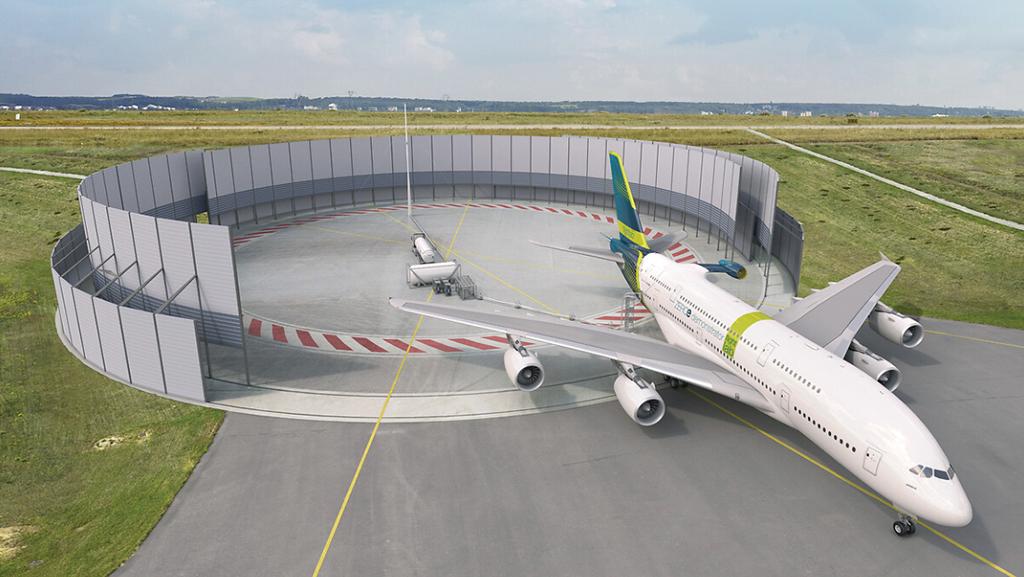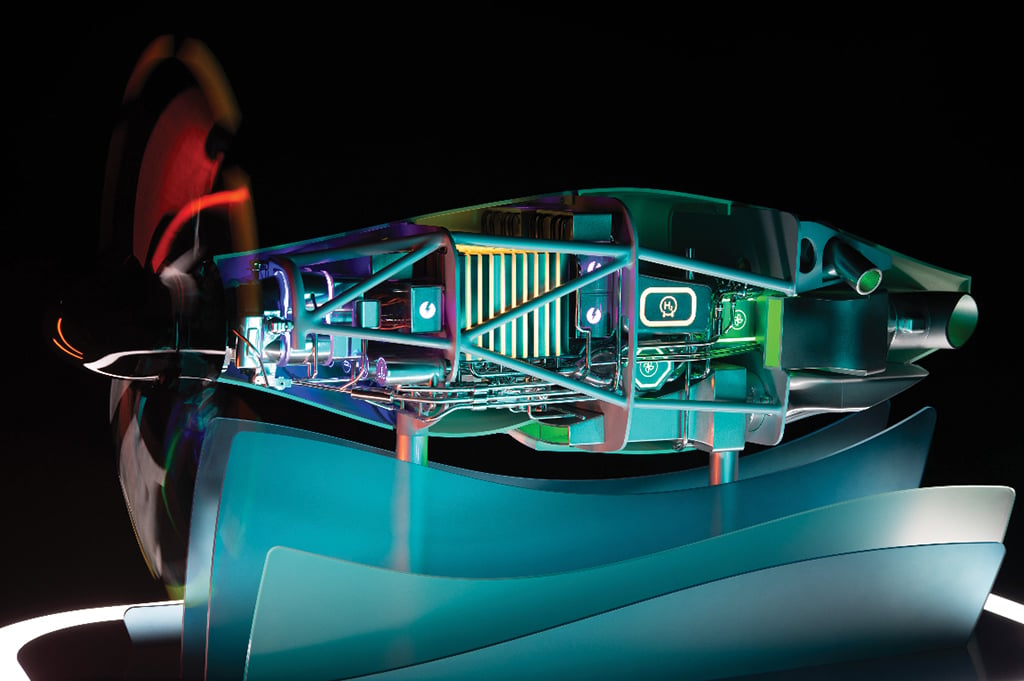
The A380 hydrogen demonstrator will be used to test both direct combustion and fuel-cell propulsion.
Airbus has provided more detail about the accelerating design work underway on two A380 technology demonstrators targeting advanced propulsion evaluations for next-gen single-aisles planned for launch in the 2027-28 timeframe.
The airframer is collaborating with GE Aerospace and Safran Aircraft Engines joint venture CFM International on two major flight-test programs that will run almost concurrently. One A380 will be used to evaluate a GE Passport engine modified for direct combustion of hydrogen fuel while the second will flight test the open-fan propulsion system being developed under CFM’s Revolutionary Innovation for Sustainable Engines (RISE) program.
In November 2022, Airbus revealed the hydrogen-fueled Passport A380 test-bed will also be adapted to evaluate a hydrogen-fuel-cell-powered high-speed propeller engine. The 2.1-megawatt engine, resembling a conventional turboprop, will be fitted on the same upper-fuselage wing stub that is also being designed to test the Passport. The fuel-cell engine test campaign is scheduled for the same period, 2026-28.
- Hydrogen tested as separate system
- Loads and noise part of open-fan tests
Both technologies use liquid hydrogen and are being explored in parallel, says Glenn Llewellyn, Airbus vice president for zero-emission aircraft. A decision will be made later, in time for entry into service by 2035, he adds.
Although both testbeds are not due to enter flight until after the middle of this decade, work on the sophisticated demonstrators is already getting underway, says Frank Haselbach, head of propulsion engineering at Airbus. “The teams are spooling up. We’re having good cooperation with CFM on both programs so we’re quite happy about that,” he says.
Both the RISE and hydrogen flight-test campaigns form part of Airbus’ technology push toward a “ZEROe” carbon-neutral airliner for service entry by 2035. The modified A380s will be used to conduct tests in the second half of this decade based at the company’s flight-test facility in Toulouse. Ahead of the A380 test flights, CFM will perform engine ground tests, along with flight-test validation on GE’s Boeing 747-400 flying testbed at GE Aerospace’s Flight Test Operations center in Victorville, California.

The hydrogen test effort is aimed at “how we actually make sure that we have a safe or safer operation than today with such a sustainable aircraft—and that includes things like liquid hydrogen, because with gaseous hydrogen you wouldn’t get the range,” Haselbach says. Focus areas will include tests of higher-density liquid hydrogen, storage tank and fuel-system distribution technology, ground and flight operations, fueling infrastructure and combustor design.
“But to really make this meaningful, we decided to put it toward a flight test that also helps to drive the teams together and gets us thinking about how we get this integrated into the aircraft,” Haselbach adds. “How do we make it safe for flight, even in an experimental environment? That was the key decision here.”
The A380 hydrogen testbed is still “a technology demonstration and by no means a product,” he emphasizes. “It will give us the answers we need, and working toward a flight demonstration helps to actually do it with the right focus.” The demonstrator will be modified to carry the Passport on a pylon projecting from the aft fuselage of the A380, while the interior will be equipped with liquid-hydrogen tanks.
“We could have done it on a smaller platform than an A380, but it will be good to actually have more space. Also, the layout of the fuselage structure enables us to have a reasonably short distance between the tank and the engine, so all of that actually helped a little bit,” Haselbach says.
“In addition, you can almost set up the entire hydrogen test system as a separate section or area on the aircraft,” he continues. “We’re not going to be interacting with any of the other systems, so rather than modify the fuel and propulsion system on an existing aircraft, it made a lot more sense to develop this as a pure flying testbed.”
For the hydrogen fuel-cell work, Airbus has been cooperating with power specialist company ElringKlinger; the two formed a joint venture in 2020 called Aerostack. The fuel cell in the test engine uses a scalable arrangement that puts together cells in stacks and channels. The test engine is being assembled in Hamburg, Germany, and has been assessed at the subsystem level. Airbus says electric motor tests are also underway.
“At scale, and if the technology targets were achieved, fuel-cell engines may be able to power a 100-passenger aircraft with a range of approximately 1,000 nm,” Llewellyn says. “We are giving ourselves additional options that will inform our decisions on the architecture of our future ZEROe aircraft.”
A hydrogen fuel cell and its associated electric motor and propeller are expected to be more efficient than burning hydrogen in a gas turbine. Other benefits include the absence of NOx and an even lower probability of forming contrails, which are proved to contribute to global warming.
The RISE demonstrator on the A380 is aimed at testing the potential fuel-burn savings from CFM’s open-fan configuration and will be the first single rotating and stator-stage tractor configuration of its type to be flight tested at full scale. “We’ve seen the fairly promising concept of the open fan before in the 1980s and 2000s, and so this is really the third time,” Haselbach says. “It’s still a technology demonstration and not a product concept at all today, but clearly it is a promising offering because you have a single fan rotating rather than two counter-rotating. That makes noise management easier, and the mechanics are simpler.”
Building on previous open-rotor and propfan concepts and demonstrators, RISE takes the approach to new levels, he adds. “Now you have the adjustability of the fan and the stator, and that gives you effectively a high-performance sort of low-pressure system at a good sort of cruising Mach number. The second stage takes the swirl out, so that’s the key benefit. Otherwise, a normal turboprop would actually fall off [in performance] at around Mach 0.6 or thereabouts,” Haselbach says.
The open-fan demonstrator will be fitted with a large support pylon on the No. 2 inboard left engine test position. The inboard wing structure and adjacent areas of the fuselage also will be reinforced to accommodate the CFM engine, which is currently expected to feature a rotor diameter of around 13 ft.
“We will be looking at the aerodynamic integration of that concept because it’s quite a big fan,” he notes. “Specifically, this means studying how it will interact with the lift/drag ratio of the wing and the structural interaction in terms of the moments that an open fan generates with extra forces,” Haselbach says. Other areas will include acoustic evaluations—both in terms of community and cabin noise as well as monitoring of interactive noise generated between the fan and the stator.
“From what we have seen so far of this in simulation, the first set of work is quite promising,” he notes. “Not everything is solved, but it’s actually good enough to say ‘OK, let’s have a closer look.’ And that’s exactly what we have decided to do together.”






